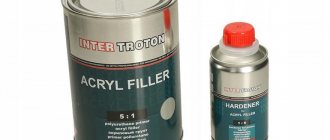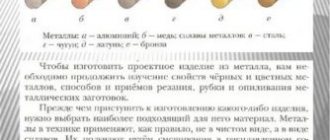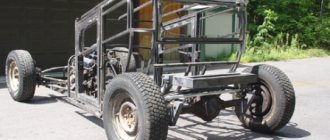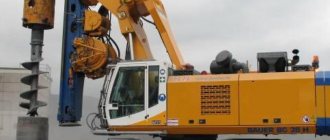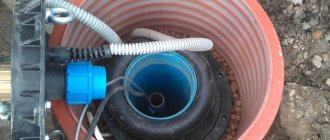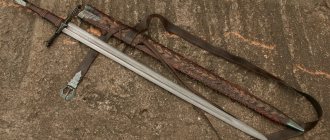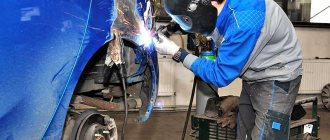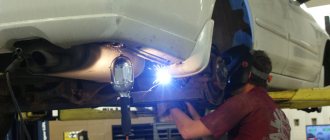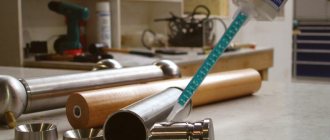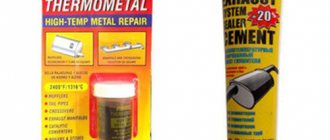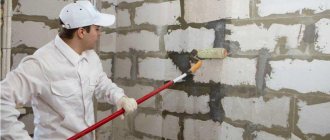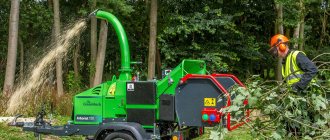When processing a car body to create a uniformly smooth surface, it is almost impossible to do without a primer. Correctly selected acid, epoxy or acrylic primer for a car creates additional protection, eliminates dents and irregularities, and ensures a tight fit of paintwork materials. The most popular due to its ease of use and quick-drying properties is acrylic. However, other types of primers have their own advantages and applications.
What is the soil for?
Automotive primer (from German der Grund - “soil”, “base”) is a specialized viscous mixture that tends to harden and acts as an intermediate layer between metal and paint.
It performs a preparatory function and solves the following tasks:
- ensuring the anti-corrosion resistance of the body and parts, protecting them from moisture and rust;
- improving the adhesive properties of the surface when applying paint and varnish;
- elimination of dents, cracks and chips during cosmetic repairs of the car;
- increasing the service life of car enamel, its strength and preservation of appearance;
- creating a flat surface for painting a car, which ensures good quality of work performed.
The chemical industry produces and markets a large number of base mixtures, differing in composition, number of components and purposes of use. They are sold in liquid and paste form, packaged in cans or aerosol cans.
Based on their protective properties, all types of primers can be divided into 4 groups:
- Passivating. Used for processing the bottom, sills and wings. The surface treated with this composition is impervious to water and air.
- Protective. Slow down the spread of the lesion in case of damage to the paintwork.
- Phosphating. As a result of their use, the surface layer of the metal is corroded and a protective film is formed due to the formation of poorly soluble substances.
- Modifiers. They are applied directly to rust, preventing the spread and increasing resistance to its reappearance. For the protective reaction to occur effectively, a temperature of at least +15°C is required.
The feasibility of purchasing a primer
The primer for metal surfaces contains inhibitors. Their function in this case is the maximum delay or suppression of physical and chemical processes, i.e. development of corrosion. The influence of moisture and oxygen usually becomes the main reason, requiring advance protection of metal structures from imminent destruction. Any surface is susceptible to negative external influences, except when properly treated. Application of any type of primer guarantees the transformation of the emulsion composition into a colorless film that protects the product. This process must precede the finishing decorative treatment of the surface. Its main tasks are: · ensuring adhesion between external metal surfaces and finishing. Thanks to priming, the decorative material will not delaminate or crumble; · antiseptic treatment. The primer contains substances that inhibit fungus and mold; · corrosion protection. The primer prevents the appearance of rust; · reducing the consumption of decorative coatings. Metal primer for exterior work must be chosen wisely, which will reduce its consumption and obtain the expected high-quality result. It can safely be called an indispensable basis for decorative finishing, a budget-friendly way to protect metal from corrosion.
Varieties by number of components
An important performance characteristic of a primer is its drying speed.
This indicator depends on the use of additional components when composing the mixture: filler, hardener, various chemical additives and elements.
Based on this criterion, soils are divided into 3 groups:
- One-component. They go on sale ready-made. Before starting work, just stir them until they have a homogeneous consistency. They are used extremely rarely in auto repair shops and service stations due to the long drying period (several days).
- Two-component. Before use, they require adding a hardener, which saves a lot of time when working. Dries in 24 hours.
- Ethanol. Used to eliminate defects in minor damage. They use the ability of alcohols to quickly evaporate, which allows the composition applied to the surface to dry within 1 hour. In both soft and hard consistency, they are convenient for application and subsequent sanding.
Types of primers
To maximize the prevention of corrosion, the primer should be selected taking into account its main characteristics, such as: the basis of the composition, adaptability to certain types of metals, feasibility of use in external finishing work. You will have to choose among very different soil mixtures.
Phosphating
Suitable for all metals, but used primarily for coating steel surfaces. The composition is based on a mixture of solvent and phosphoric acid, which has high heat resistance (withstands up to 220°C). Paint adheres well to such a primer; it is preferable to apply it to coatings that are not affected by corrosion. When finishing external structures, it does not always provide the expected protection.
Acrylic
Compositions characterized by safety, absence of unpleasant odor and high drying speed. Acrylic-based primer mixtures allow you to hide minor defects on external metal surfaces, create a durable anti-corrosion coating, and ensure good adhesion. Water-based acrylic primer can be used on various types of metals that are not damaged by rust.
Passivating
Used for aluminum metal structures and products made from other ferrous metals. The main components are chromic acid salts (it is important that their concentration is high). They prevent the interaction of external structures with the environment, which eliminates the development of corrosion processes. The group of these primer mixtures includes alkyd, polyurethane and epoxy.
Tread
They are used for various metals and have enviable anti-corrosion properties. The main components of the mixtures: aluminum, magnesium or zinc powders (their content can reach 90%). They create a strong outer protective film, preventing rust from spreading. Even if cracks appear on the structure, the zinc components of the soil will protect it from corrosion.
Inhibiting (two-component formulations)
Can be used for all types of metals. After application, the mixtures are converted into enamel primer, excellent for its high anti-corrosion properties. They are water- and oil-soluble. They are not suitable for processing external metal structures that may be subject to heating in the future, since the protective film will emit an unpleasant odor.
Insulating
Mainly used for ferrous metals, but can also be used for non-ferrous metals. The main components of the mixtures are neutral pigments and lead white. They are not capable of providing a long-lasting effect, so they are hardly suitable for exterior finishing work. They also cannot be painted.
Transformative
Designed for external metal structures damaged by corrosion. The composition is based on surfactants. They convert existing rust into an anti-corrosion film. To ensure complete protection of the metal, it is necessary to combine this type of primer with a passivating mixture.
Classification by composition
The composition of the mixture determines the place and technology of its application. The presence of aggressive acids in the primer forms a protective film due to chemical interaction with the metal. The presence of resins provides physical impermeability to moisture.
The addition of zinc, aluminum, and chromium powders creates the effect of galvanized body and parts, and inert particles guarantee water repellency.
In addition, application is carried out on different materials and each of them requires its own mixture.
All primers for cars are divided into 2 main types:
- Primers (from the English prime - “main”, “first”), intended for primary processing. Their main tasks are to create anti-corrosion protection for the body and ensure better adhesion of the car enamel to the surface.
- Fillers (from the English fill - “fill”). They are used during secondary finishing for leveling, forming a substrate for paint and protecting against weak mechanical influences.
Acidic (for rust and problem areas)
The action of these compositions is based on the principle of passivation or phosphating, since the most commonly used component in them is phosphoric acid. It allows you to implement the mechanism of adhesion to the surface:
- penetration of the primer into the metal structure to a depth of 0.05 microns due to corrosion of the surface;
- entering into a chemical reaction with the formation of sparingly soluble phosphates;
- the formation of a durable anti-corrosion film from them during hardening.
It is recommended to apply the primer in 2 layers, as a result of which its maximum possible adhesion to the surface being treated is achieved. This provides not only protection against rust, but also high quality and durability of the paintwork. The adhesion process of acid mixtures is equally effective with any alloys from which a car can be made (galvanized and galvanized steel, non-ferrous metal, aluminum alloys, etc.). The aggressiveness of the impact is used to process hard-to-reach places and parts.
It should be taken into account that it is no longer acceptable to putty on such a surface. Application of the material causes a reaction that destroys the primer layer.
Epoxy for metal
Another equally popular group of primers are epoxy resin-based primers. When using them, material properties such as viscosity and density are used. Resins create an air- and moisture-proof thick layer up to 0.15 microns, which provides long-term (up to 7 years) protection for treated parts. The use of such mixtures prevents the appearance of bubbles, and the increased stickiness allows them to be applied over putty, metal and remnants of old paintwork.
Epoxy primers do not require sanding. You can putty and paint over them without waiting for complete drying. And although it is recommended to apply a layer of acrylic on top of them, practice shows that this is an unnecessary precaution. Being chemically neutral, epoxies can act as an insulator between problematic or incompatible surfaces and materials.
Acrylic primer
Acrylics belong to the class of fillers (secondary primers) and are intended to eliminate minor risks and surface defects remaining after sanding, as well as to create a substrate for final painting. To ensure color stability, they use colored pigments: red, black, white and gray. For minor abrasions and scratches, this makes the damage invisible, and also increases the covering power of the enamel and saves its consumption.
Many acrylic mixtures allow for a “wet on wet” painting method. This eliminates grinding and saves processing time and labor costs. But the mixture should be applied in 2-3 layers to create a thickness of 100-150 microns. Acrylics are resistant to temperature fluctuations, humid conditions, and mechanical vibrations. You can work with them on both metal and plastic.
They are two-component; depending on the TDS, they are mixed with a hardener and solvent in various ratios - 5:1, 4:1 or 3:1. This determines the viscosity and adhesive properties of the resulting material. But single-component aerosol levelers, produced in cans, have gained particular popularity. They are convenient for cosmetic repairs, do not take time to dilute the mixture and dry quickly.
Composition for plastic parts
To prime plastic parts (bumpers, fenders, interior decorative elements), special adhesive compounds are used, which are applied in one layer and create strong adhesion to the material. This is achieved by liquefying the surface and then hardening it. Most often, one-component acrylic and alkyd mixtures are used for these purposes. They are transparent, and to distinguish the primed surface from the untreated one, a little silver paint is added to them.
However, in 80% of cases, plastic parts go on sale already prepared and do not require reprocessing.
Features of choice
First of all, anti-corrosion mixtures are selected based on the type and condition of the metal that needs to be treated. The main purpose of a primer when coating ferrous metals is to slow down corrosion. Iron, cast iron, black steel and alloys based on them used for outdoor work are very susceptible to corrosion due to interaction with a merciless environment. For these materials, if they have already begun to rust, a converter should be used as a priority. It will at least partially eliminate traces of corrosion. If the primer mixture is selected for external products made of non-ferrous metal or alloy, for example zinc, copper, brass, aluminum, then its primary function is to ensure maximum adhesion between the treated surface and other finishing material. For this purpose, you can choose compositions based on organic solvents, with a urethane base, and containing zinc. They can be used as a protective coating for galvanized iron or steel. Bronze, brass and copper are best protected with polyurethane or epoxy varnish. On sale you can find types of primers for metal that are applied to hide difficult to remove stains, for example, from grease, soot, etc. This step in the repair cannot be skipped if you do not want the stains to reappear over time or provoke peeling of the decorative finishing. After choosing a primer, you can begin to study the instructions for its external use.
IMPORTANT: 1. pay attention not only to the properties and types of primer, but also to the form of its release. To dilute powder bases and concentrates, it may be necessary to purchase a special solvent; 2. check the compatibility of the selected primer mixture with the planned decorative coating - they may be incompatible.
Advantages and disadvantages of soils
Despite the fact that the primer is not visible at the end of the work, both the quality and durability of the completed painting depend on it. After high-quality coating application, the following are guaranteed:
- protection against rust and corrosion;
- smooth substrate for painting;
- presentable appearance of the car;
- there are no reasons for cracking, bubbles and subsidence in the enamel.
What primer should be chosen to achieve this is up to the car owner to decide for himself, but one piece of advice from the experts is worth listening to. The point is that you cannot skimp on this mixture.
You should choose proven brands: only in this case can you count on getting a high-quality result.
Cheap primers are dangerous because during drying they shrink unevenly, which leads to disruption of the evenness of the coating, loss of appearance, the formation of cracks and the formation of rust.
Advantages of priming before painting
Priming the metal allows you to minimize damage from the influence of various factors and extend its service life. In addition, its use depends on:
- quality of application of decorative coating to the product;
- its durability;
- protection from the destructive effects of corrosion and rust;
- saving paint.
If you think about it, it is better to spend a little more time on current repairs before painting and postpone the prospect of subsequent repairs for a long time. Moreover, financial costs will also be significantly reduced, because soils are much cheaper.
Popular manufacturers of primers for painting
The leading positions in surveys and ratings belong to foreign companies, among which the products of widely advertised brands stand out:
- Hi-Gear;
- Liqui Moly;
- Dynacoat;
- Mobihel;
- NOVOL;
- Duxone;
- ABRO.
Domestic manufacturers, distinguished by high-quality products and gaining fame in the country, are represented by the following companies:
- “Russian Paints” (Yaroslavl);
- Moscow LLC "Empresa-M";
- LLC "KhimTorgProekt" from St. Petersburg.
The best primary acid soils
Among single-component acid primers that do not require the addition of catalysts, experts highlight Mobihel Primer 1K. It is convenient and easy to apply. Used for priming on steel, galvanized and aluminum. Has a short drying time. Estimated price 950-1 thousand rubles. for 1 l.
In two-component ones, a hardener is added, often included with the main mixture. Widespread:
- NOVOL Protect 340 Wash Primer - used on ferrous and non-ferrous metals. Hardens quickly. Does not require sanding, but acrylic processing is required. Sold together with hardener. Average prices: 500 rub. per set 0.2+0.2 l; 1.9-2 thousand rubles. — 1+1 l.
- Radex CR 1+1 Activator - applied to any metal surface. Recommended for repairing new cars. The price for a set of 2 cans ranges from 2 thousand rubles. up to 2.5 thousand rubles.
What else is important to know?
Even taking into account the high quality characteristics of this material, you should not apply it directly to a rusty surface, since the expected effect will not be achieved. The rust converter is not able to penetrate too deeply into the surface being treated, so areas heavily affected by rust cannot be completely removed. But preliminary cleaning of the treated surface can enhance the effect of primer-enamel on rust.
Primer enamel is suitable for painting metal structures located outdoors. It is best to treat them when they are still clean or slightly corroded. It is on such surfaces that anti-corrosion primers are most effective. If the surface of the product being processed has been exposed to weather conditions for too long without protection, then primer-enamel will clearly not be enough to treat it.
So there is no need to give a 100% guarantee for removing traces of rust from a metal surface treated with primer-enamel. It all depends on the degree of rust damage to the material being processed. But timely treatment at the early stage of corrosion with such a composition will give positive results. In other words, the smaller the area and degree of damage to the metal by rust, the easier it will be to prevent the development of corrosion on its surface.
Review of famous primers (2 videos)
Different primer mixtures for rust (20 photos)
Recommended sealer primers
A group of sealers (insulators) is designed to eliminate the possibility of contact of conflicting materials. The most effective for this purpose are viscous epoxies, which create a dense protective layer.
Acrylic primers designed for wet-on-wet work also have insulating properties. They are used either as a direct substrate for painting, or with the subsequent addition of filler.
Primers for secondary application
The functions of fillers are varied, since they are the final stage of work before applying enamel and are designed to eliminate all existing surface defects, level planes and joints, isolate problematic materials and ensure a tight adherence of paint. When working with them, it is necessary to eliminate the slightest risks and carefully polish the surfaces (to a depth of 30 microns). Leveling should remove all defects and pores remaining after putty, and level out the transition points from one plane to another.
Colored, for painting
The use of colored primers became popular in the 80s and 90s. last century. Few people imagined that such a simple know-how as adding coloring pigments to the mixture would become widespread and provide such great savings in material consumption. This especially applies to interior parts and the space under the hood. The Japanese, Koreans, and more recently AvtoVAZ have refused to paint them, considering treatment with a colored (tinted) primer coating sufficient.
High build primers
The standard thickness of primers applied in 2-3 layers is 100-140 microns. However, a number of manufacturers (Liqui Moly, AUTOP) produce compositions that, when applied, form a layer of 260-300 microns. They are convenient to use on large surfaces during major repairs. The use of such primers ensures high-quality leveling and allows you to eliminate the putty step from the processing process. These primers are most often produced in the form of an aerosol and demonstrate high-quality adhesion when painted wet.
Soil-aerosol companies
The convenience of using the compounds in aerosol cans, their ability to dry quickly and the ability to save effort and time (there is no need to dilute the mixture or work with a spray gun) were highly appreciated by repairmen. The Russian market today is dominated by such manufacturers as Kudo, Sadolin, Loctite, Jeta Pro, Brulex, NOVOL and many others. The price is also attractive - from 250 rubles. up to 800 rub. per canister with a capacity of 0.5 liters.
High-quality primers for plastic surfaces
For high-quality priming of plastic parts, their preliminary preparation is important, which consists of heating or exposing the polypropylene to an open flame (evaporation technology), subsequent matting and removal of fats and resins. The steady popularity of NOVOL, Reoflex and Liqui Moly in this area wavered after the appearance on the market of new products from the German Spies Hecker and the Japanese Kansai.
- Acid primer for cars
- Which brake fluid to choose
- The best way to treat the underbody of a car against corrosion with your own hands
- Which hard wax for cars is better?
